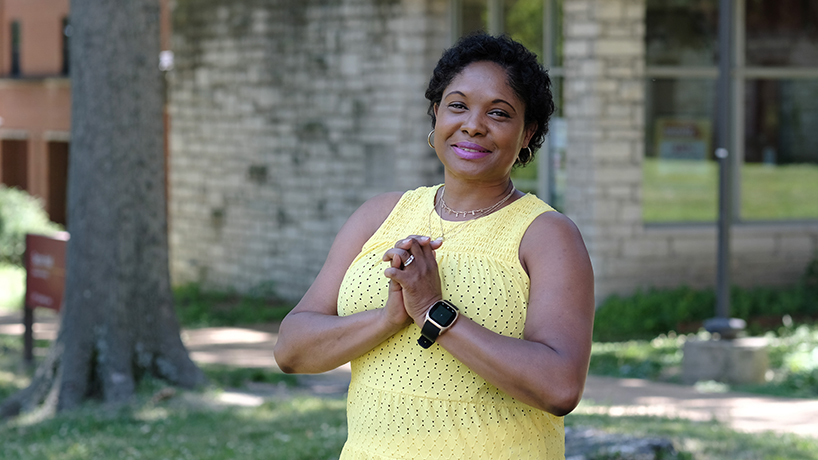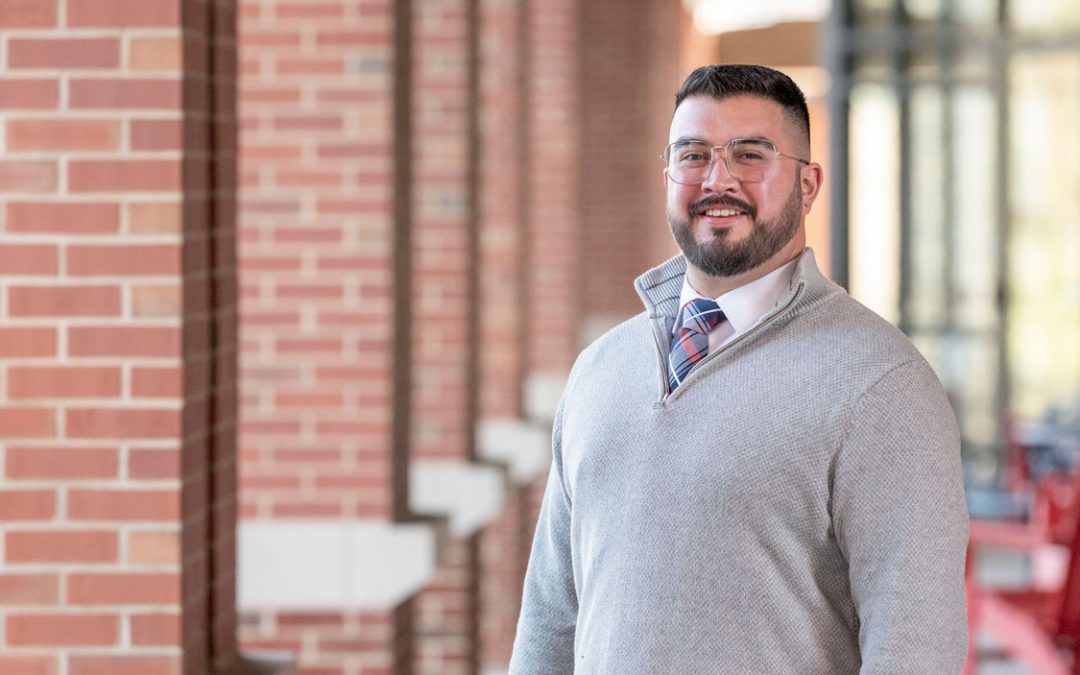
Through both her research and instruction Assistant Professor of Nursing Roxanne Reid hopes to create meaningful change in the field of nursing. (Photo by August Jennewein)
On April 5, 1968 – the day after the assassination of Martin Luther King Jr. – schoolteacher Jane Elliott split her third-grade class by eye color.
Blue-eyed students were superior. Brown-eyed students were inferior. The next day, those positions switched.
She hoped her students would experience a small taste of what it was like to live with discrimination and thus begin to confront their own biases.
Elliott kept repeating her exercise and expanded it to other populations and age groups. In 1985, PBS made a FRONTLINE episode, “A Class Divided,” helping to ensure that the lessons from Elliott’s work spread across the country. Thanks to the efforts of Assistant Teaching Professor Roxanne Reid, that includes the University of Missouri–St. Louis.
The College of Nursing faculty member uses the documentary as a sort of icebreaker for the first day of her class, Cultural Diversity in Health Care.
“I ask what it would look like if we recreated that experiment with our patients or with each other,” Reid said. “It impacts the students a lot. I’ve had students say that they went home and showed it to their parents or other people because they always had thought that their view was the right way. There isn’t a right or a wrong way to grow up, but it’s now you’re broadening your learning and acceptance of other people.”
Reid debuted the Cultural Diversity class in the summer of 2017, and it’s been taught by her and other College of Nursing instructors every semester since to all of the traditional BSN students. The intent behind it is for students to examine their biases before entering the field in order to effectively care for patients unlike themselves.
The idea for the class came from then-Associate Dean of Academic Programs Roberta Lavin. Reid, who immigrated at age 3 from the Jamaica to New York City, where she eventually created and taught a similar course at LaGuardia Community College in Long Island City, volunteered to develop the new class at UMSL.
“We’re in a profession where we are taking care of people in their lowest point,” Reid said. “If you cannot identify with that person in some way, then how could their needs be fully met? How can we truly say that we honestly took care of this patient with all the resources and abilities that we have? We can’t do that if we don’t identify our own biases.”
During class Reid takes a deep dive into the racial and ethnic breakdown of the students that reaches beyond the standard census categories. Together they delve into what those heritages mean for students’ cultural understanding.
At the start of class, Reid surveys her students on where they expect to work and generally finds that most plan to return to their own communities and haven’t considered moving out of state. By the end, that’s often changed.
“Nursing is so broad, and there’s such an opportunity out there to see other people, how cultures deal with sickness and health in their communities,” she said. “In the textbook, we can talk about it, in clinicals and in the hospital we can show you, but to get out there and actually be in the community is a different type of experience. The students are very receptive to that.”
She feels the work that her students are doing has become even more important during the coronavirus pandemic. The class discussed how the pandemic has highlighted disproportionate access to health care for different groups of people, what changes they would like to make and what they can do now. The students talked about how cultural differences, beliefs and affordability affect health care and how not everyone has equal ability to take care of themselves.
Reid also plans to do a unit on how the killing of George Floyd highlights systemic disparities.
“I’m interested to hear what the students have to say and how we can move forward,” she said. “I hope that they take away from the discussion that, even though we are different, we all have the same or similar basic needs. We all need to be treated respectfully. We all need to have the ability to care for our families and for ourselves. We all have the need to interact and socialize with other people to grow our community. I want us to be a community and not to just be about immediate family.”
The ability to create educational experiences such as the Cultural Diversity class or programs and policies is a focus of Reid’s. Her DNP emphasis was Healthcare Systems Leadership, which she sees as playing a role in creating positive and meaningful change.
The sense of community that she hopes her students learn to develop in her course is also central in Reid’s research, where she focuses on ways to improve community health care through faith-based intervention. One of her recent studies, “The Role of Church-Based Activities on Patient Activation Levels in Self-Care Management of Minority Church Members: A 12-week Case Study of an Initiative in Queens New York” – forthcoming in the Journal of Christian Nursing in July – looks at dietary health interventions using the church as a resource.
Though Reid did her research for this study in 2015 and 2016 with follow-ups the next two years, she’s seeing her work impact the community served by the church now during the pandemic. The church leadership used the same techniques to educate people about wearing masks and social distancing.
“I was really happy to see that they really came out there and took this hands-on and sustained it,” Reid said. “Stability is important in any type of research. So often in different communities, especially in low-income communities, we are guilty as researchers of going in there and doing our research and then coming out of there and not leaving any tools to support what we’ve done. I was pretty happy to know that this program was the same, and they’re still maintaining it.”














